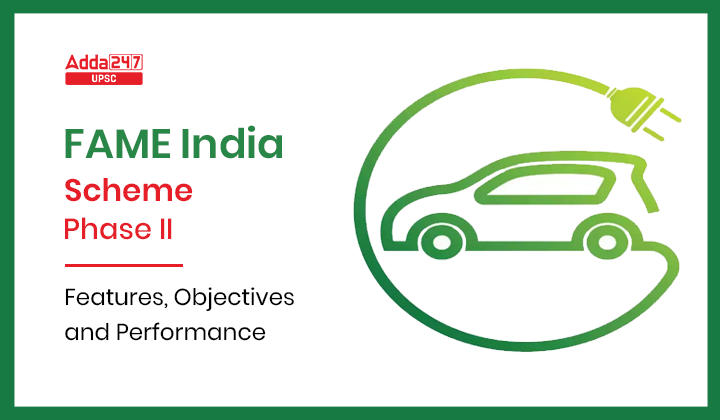Table of Contents
FAME India Scheme UPSC Exam
Phase II of FAME India Scheme: Central Government launched the Faster Adoption and Manufacturing of (Hybrid &) Electric Vehicles in India (FAME India) Scheme in 2015.
FAME India Scheme is important for UPSC Prelims 2023 and UPSC Mains Exam (GS Paper 2- Governance, Administration and Challenges: Government policies and interventions for development in various sectors and issues arising out of their design and implementation.)
FAME India Scheme Phase II in News
- Under Phase-II of FAME India Scheme, 7,45,713 Electric Vehicles have been supported till 07.12.2022 by way of Demand Incentive amounting to about Rs. 3,200 Cr.
- Further, MHI has sanctioned 6315 e-buses to 65 cities/STUs/CTUs/ State Govt. entities for intracity and intercity operations across 26 states/UT under the FAME India Scheme.
Down To Earth Magazine July 2022 (Part 1): Fire in Electric Vehicles!
FAME India Scheme
- About: The Government notified Phase-II of Faster Adoption and Manufacturing of (Hybrid &) Electric Vehicles in India (FAME India) Scheme for a period of five years commencing from 1st April, 2019.
- Budgetary Allocation: FAME India Scheme Phase II was launched with a total budgetary support of Rs. 10,000 crore.
- Out of total budgetary support, about 86 percent of fund has been allocated for Demand Incentive so as to create demand for xEVs in the country.
- Mandate: Phase-II of FAME India Scheme mainly focuses on supporting electrification of public & shared transportation.
- FAME Subsidy: Under FAME India Scheme, incentives are provided to buyers of electric vehicles in the form of an upfront reduction in the purchase price of electric vehicles.
Key Features of FAME India Scheme Phase II
- Applicability: With greater emphasis on providing affordable & environment friendly public transportation options for the masses, scheme will be applicable mainly to vehicles used for public transport or those registered for commercial purposes in e-3W, e-4W and e-bus segments.
- However, privately owned registered e-2Ws are also covered under the scheme as a mass segment.
- Key Objectives: Phase-II of FAME India Scheme aims to support through demand incentive-
- 7090 e-Buses,
- 5 lakh e-3 Wheelers,
- 55000 e-4 Wheeler Passenger Cars and
- 10 lakh e-2 Wheelers.
- However, depending upon off-take of different category of xEVs, these numbers may vary as the provision has been made for inter as well as intra segment wise fungibility.
- Only advanced battery and registered vehicles will be incentivized under the scheme.
Steps taken by Government to Facilitate Adoption of Electric Mobility
- Increased Demand Incentives: From 11th June, 2021 the demand incentive under Phase II of FAME India Scheme has been increased to Rs. 15,000/KWh from Rs. 10,000/KWh with an increase in cap from 20% to 40% of the cost of vehicle, thus enabling cost of Electric two wheelers at par with that of ICE two wheeler vehicles.
- Extension of Phase II of FAME Scheme: on 25th June, 2021 Phase II of FAME India scheme was extended for a period of 2 years upto 31st March 2024.
- Production Linked Incentive (PLI) Scheme: government approved the Production Linked Incentive (PLI) Scheme for manufacturing of Advance Chemistry Cell (ACC) in the country in order to bring down prices of battery in the country.
- The drop in battery prices will result in cost reduction of Electric Vehicles.
- Electric Vehicles are covered under Production Linked Incentive (PLI) scheme for Automobile and Auto Components, which was approved on 15th September 2021 with a budgetary outlay of Rs. 25,938 crore for a period of five years.
- GST Reduction: GST on electric vehicles has been reduced from 12% to 5%; GST on chargers/ charging stations for electric vehicles has been reduced from 18% to 5%.
- Permit Exemptions: Ministry of Road Transport & Highways (MoRTH) announced that battery-operated vehicles will be given green license plates and be exempted from permit requirements.
- Tax Concessions: MoRTH issued a notification advising states to waive road tax on EVs, which in turn will help reduce the initial cost of EVs.
NITI Aayog report on Electric Vehicles




 TSPSC Group 1 Question Paper 2024, Downl...
TSPSC Group 1 Question Paper 2024, Downl...
 TSPSC Group 1 Answer key 2024 Out, Downl...
TSPSC Group 1 Answer key 2024 Out, Downl...
 UPSC Prelims 2024 Question Paper, Downlo...
UPSC Prelims 2024 Question Paper, Downlo...
